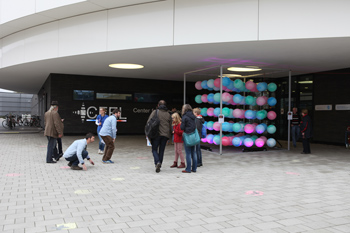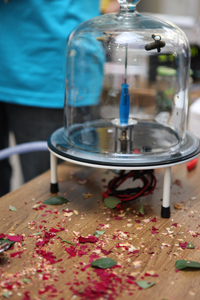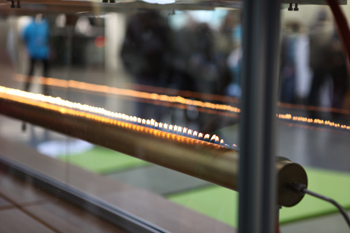Night of Knowledge 2015
Experience science with all your senses
More than 18,000 visitors set off Saturday 7th November to get insight into the research facilities during the DESY DAY and Night of Knowledge on campus Bahrenfeld. 9,500 visitors came alone to CFEL.
The exhibit Unit Cell was a special attraction right in front of the CFEL: The sound installation made it possible to sensually perceive the research field of crystallography: an array of 125 balls takes over the function of the chrystal whereas the X-rays are replaced by sound waves. “If you go into the crouches, the loud sound field will suddenly turn silent,” artist Dominic Hopkinson explained. Unit Cell was conceived and designed during the ASMbly arts by members of The Superposition collective and Prof Ben Whitaker and Dr Mike Nix (Scientists) of Leeds University. At the initiative of Arwen Pearson, professor of the excellence cluster CUI, the sculpture was recreated together with CFEL and CUI for the Night of Knowledge.
In the CFEL foyer numerous experiment stations awaited the visitors. Researchers from the different scientific departments of DESY, the Max Planck Institute for the Structure and Dynamics of Matter as well as the University of Hamburg fascinated the visitors with a laser show, with an interactive science quiz, with the presentation of an inverted pendulum, a cucumber engine, the determination of light speed with chocolate in a microwave, with Kundt’s tube, and with the opportunity to experiment with the structure of proteins on the computer. A never-ending queue lined for example in front of the stand that produced ultrafast films of the guests with a high-speed camera. A balloon filled with confetti burst above the heads or soap bubbles filled the room – all filmed with 1,000 pictures per second.
Overall, at the sixth edition of the Night of Knowledge more than 1,000 activities at 5 universities and a great number of research institutions attracted curious visitors to discover the scientific landscape of Hamburg. With more than 30,000 citizens interested in science the Night of Knowledge celebrated a new visitor record.


